Gross Anatomy
Feeding Time
Following Up
Conclusion
Frequently Asked Questions
Errata and Clarifications
Appendix: More Magazines
More articles
Discuss this article at

Appendix: More Magazines
No sooner had I posted this analysis than I found myself in possession of more magazines to analyze. Rather than go back through the existing pages and laboriously insert new data, I'm going to append descriptions of any new magazines that cross my path to this page.
"USGI" Magazines
Lazarus from the M1911.org forum was kind enough to furnish a pair of magazines marketed as USGI magazines. I've seen these magazines sold at gun shows and online, both times in little brown paper envelopes. Just for the sake of scientific objectivity, let's assume that it's possible there actually exists a decent possibility that there are vast, untapped troves of new magazines for a sidearm the US military discontinued in the 80s, and that this trove is being sold for very low prices. That way, instead of just snorting at the admittedly oxymoronic phrase, "new USGI magazines", we can instead ask if these magazines actually are new USGI magazines.
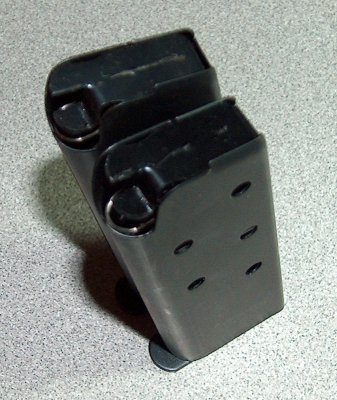
The real deal?
If you're wondering whether or not a magazine is USGI or not, then just read my lips: Read the magazine's lips. The full-length tapered lips are what to look for. The picture above shows the magazines' lips, but let's take a closer look just to be sure.
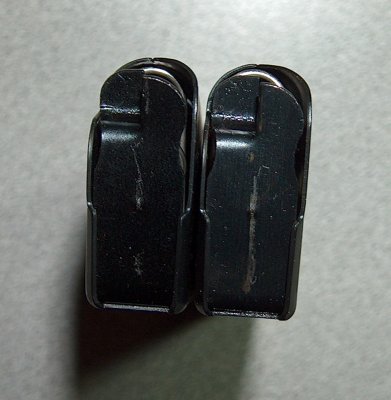
Just lip service.
These are wadcutter-style lips with some of the sharpest releases I've seen. They should work fairly well when used with an in-spec gun, but USGI they are not. What confuses the issue is the presence of what appears to be USGI-style lettering on the magazine baseplates:
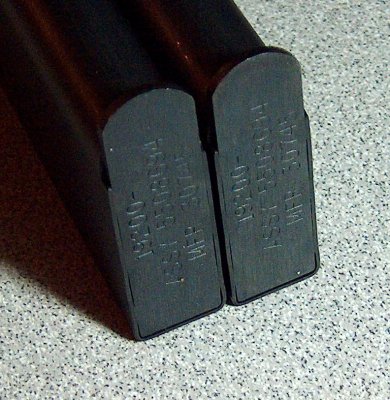
The lettering looks suitably obscure, but to my eyes doesn't seem to be stamped, but laser-cut. Note also how the welds on the baseplates look pretty spotty. They are spot-welded, after all, but nonetheless leave something to be desired where quality is concerned. Speaking of quality, look at the weld on the magazine:

Not too weld done.
As astute observers may already have noticed, these magazines have the welds on the front, instead of on the rear. I'm somewhat at a loss for the reasoning behind doing it this way, although if one doesn't intend to sand down the weld, it's probably less likely to affect the overall magazine shape if done at the front; it might also make shaping the magazine body easier. Either way, it's not how the original USGI mags were put together.
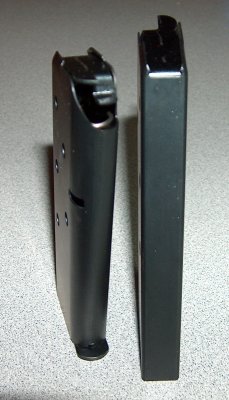
Magazines front and back.
Finally, the witness holes in the magazines are cut a lot wider than is commonly seen on 1911 mags; they also don't go as far down the magazine body as normal. Whether because of the size of the holes or due to some other aspect of magazine construction, these mags feel abnormally light.
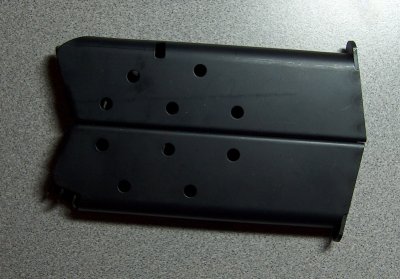
Holes. Note the weld spots at the bases, too.
It's safe to say these aren't true USGI magazines; however, are they really that bad? I'm inclined to shrug my shoulders and make some sort of indeterminate grunting noise. Hand-cycling these magazines revealed no drastic flaws; in fact, the feeding pattern was so textbook wadcutter that I didn't take photos of the feeding, as they would have shown nothing that hasn't already been demonstrated. If one's 1911 is in spec, these magazines aren't likely to throw things off, but they aren't the boon to smooth feeding offered by the genuine deal.
Again, my thanks to Lazarus for supplying the magazines for analysis.
email: hidi.projects at gmail.com